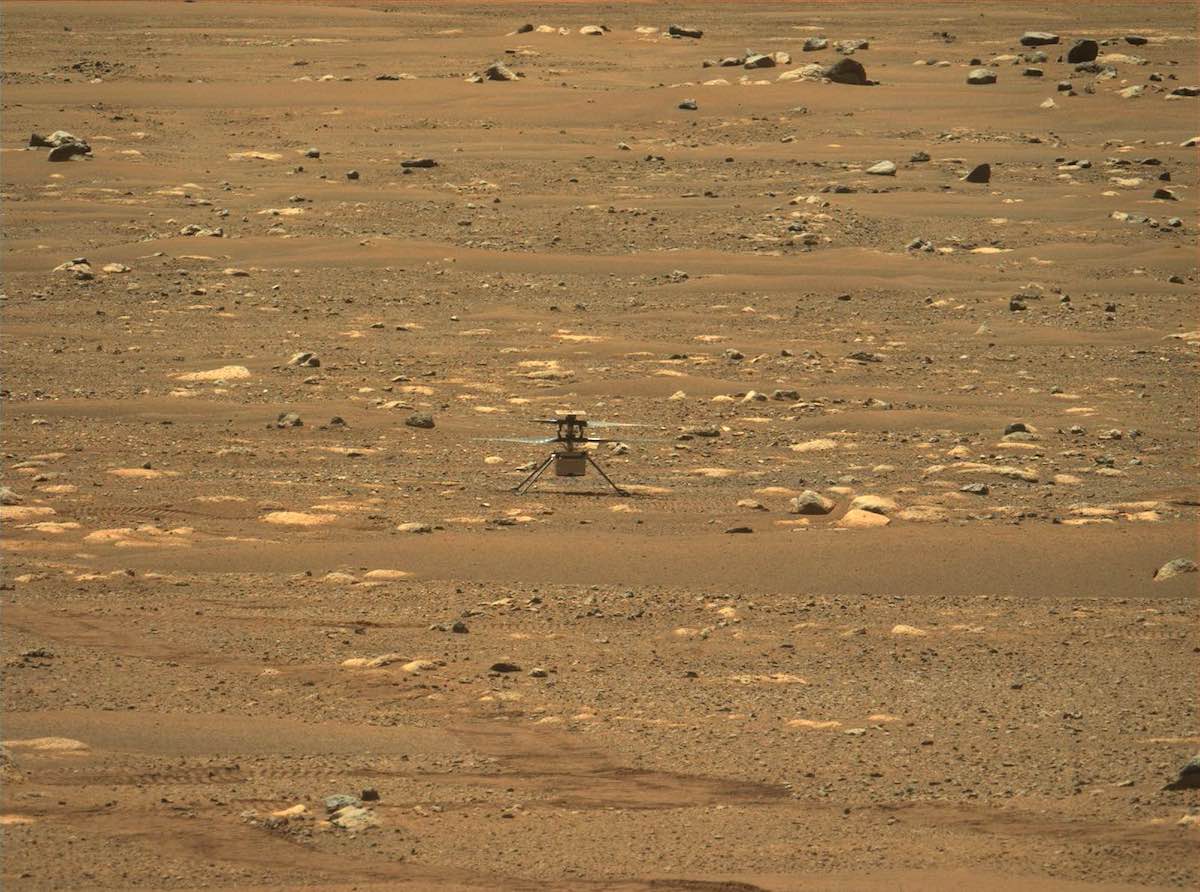
The first-ever powered flights over another planet have proved a resounding success for NASA’s JPL team, which is celebrating Ingenuity’s 12-month anniversary of its first helicopter hop on Mars Tuesday.
Some 25 flights later, the Ingenuity helicopter — which hitched a ride to Mars on NASA’s Perseverance rover — is going from strength to strength.
Speaking exclusively to Spaceflight Now, Jaakko Karras, Ingenuity chief engineer at NASA’s JPL, Pasadena, California, said: “It’s an exciting milestone and Ingenuity really has exceeded all our best expectations.
“We’re here commemorating the anniversary of the first flight but, even prior to the first flight, just deploying safely onto the surface of Mars was a huge, huge moment for the team.”
Ingenuity’s historic first flight proved a modest beginning, a mere 10 foot high hover over the Martian surface.
“At that point in the demo we would have considered ourselves lucky to get a full five flights to complete the tech phase,” said Jaakko. “So a big highlight of the past year was getting the five flights of the demo phase under our belt and still being healthy.
“With the extension we got to transition from tech demo to operations demo and in that operations phase we were able to actually fly along with the Perseverance rover and scout out terrain.
“That’s been a huge accomplishment for us because the whole Mars helicopter concept really began with that vision, demonstrating air mobility so that it can be used as a scout. We never expected to be able to play that out because just demonstrating the feasibility of flight was really the main goal and an incredible achievement in itself.”
Ingenuity completed its technology demonstration phase after three successful flights. For the first one on April 19, 2021, it took off, climbed to about 10 feet (3 meters) above the ground, hovered briefly, completed a turn, and then landed.
It was a major milestone: the very first powered, controlled flight in the extremely thin atmosphere of Mars, and, in fact, the first such flight in any world beyond Earth. After that, the helicopter successfully performed additional experimental flights of incrementally further distance and greater altitude.
The 4-pound (1.8-kilogram) Ingenuity notched up it 25th flight over the red planet on April 8, setting new personal bests for speed and distance.

“We’ve flown 25 flights over all kinds of different terrain and now through different Martian seasons,” added Jaakko, who has been a member of the helicopter operations team at JPL since its first launch.
“My highlight has undoubtedly been the versatility and adaptability of both the vehicle and the team to allow the vehicle to do all these things that it was never designed for, never intended for.”
Ingenuity’s 25th and most ambitious flight to date proved another record-breaker. The helicopter broke its distance and ground speed records, traveling 2,310 feet (704 meters), flying for a total of 161.3 seconds at a speed of 12 mph.
Previously, the helicopter had only reached speeds of about 11 mph and flew just over 2,000 feet, though it did stay in the air for 169.5 seconds last August.
NASA’s car-sized Perseverance rover, which landed inside the Mars’ Jezero Crater on Feb. 18, 2021, is tasked with searching for signs of ancient life on the Red Planet and collecting dozens of samples for future return to Earth. The rover is currently heading to a river delta area within the crater.
“We intended to get there with Ingenuity slightly ahead of the rover, but as these things go, it turned out that there were various challenges in crossing the seas, and the natural terrain there was a little bit more challenging then we’d hoped for,” Jaakko explained.
“So we had to re-plan the flights a little, and take some time here and there to reassess, but we’re still making progress to the river delta and then, once we get there, the plan is to continue scouting that terrain for Perseverance, which is going to be in that region for some time on a science campaign.”
Jaakko told Spaceflight Now that Ingenuity had done so well in its first year that it was beginning to make its flights over Mars look “routine and easy”.
“But they are certainly not,” he added. “Every flight is unique in its own way, they have different types of terrain, they have different types of Martian soil, which means different energy calculations and thermal assumptions, and so there is a lot of analysis, a lot of prep work.”
Asked about his expectation on Ingenuity’s capability to keep operating, Jaakko said he was quietly optimistic.
“The system overall is still in very good health. There isn’t a single component that is looking like a limiting factor, and we can’t point to any one thing as being a concern.
“That said, the nature of operating Ingenuity is still venturing into the unknown. Any given flight on any given week could be the last because this is obviously not a risk free endeavor. There are lots of risks but we try our best to keep them at bay.”
